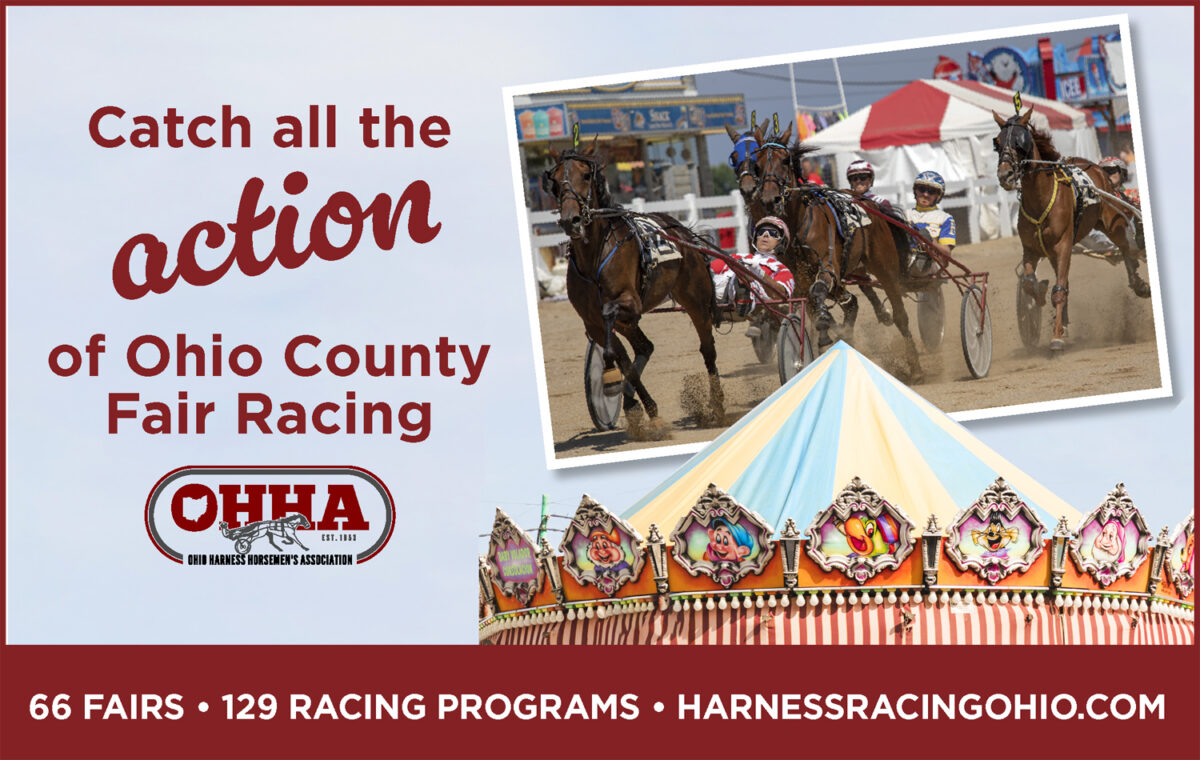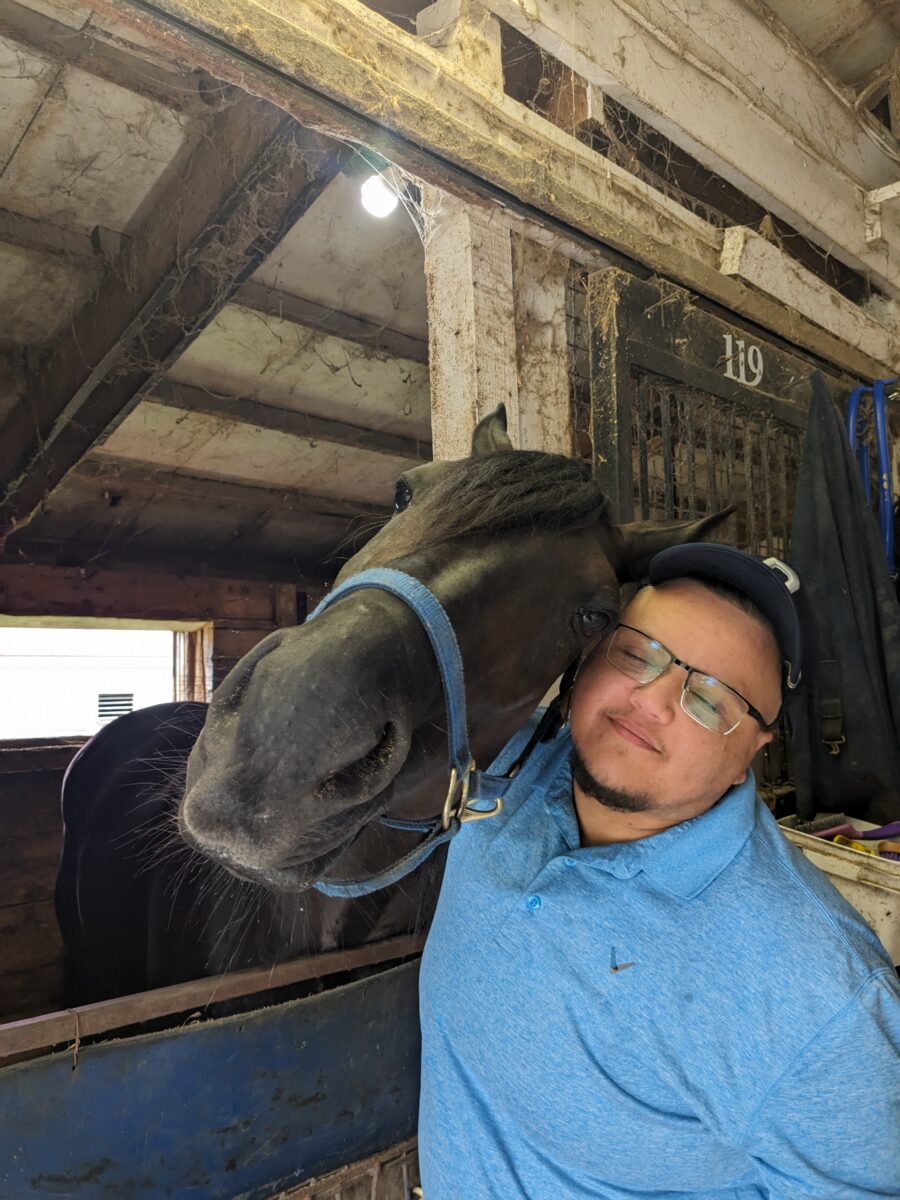

“People can’t afford to go work with the horses”
The story of why caretaker Kris Lamont left the game.
by Melissa Keith
Kris Lamont loves horses, and horses love him. He’s an experienced Ontario standardbred caretaker who now lives in Nova Scotia, works at a bank, and catch-paddocks at Truro Raceway.
The “Standardbred Jobs in Ontario’’ Facebook group has over 45,000 members. There are posts about employment opportunities, but also comments from would-be grooms, explaining why they can’t apply. Lamont’s story covers the common reasons why he and others have left full-time positions as caretakers, particularly in the years after the Ontario Slots at Racetracks Program ended.
Lamont said he had an early advantage because his family lived in rural Ontario.
“So, I learned, growing up, how to drive a team of horses,” he said. “My father taught me; my grandfather taught me; friends of ours would teach me. I learned how to brush a horse, how to pick a hoof, right from day one. I don’t know that I ever had formal lessons in anything.”
There was a learning curve that took him to some of the top stables in the business, but Lamont said he started out with a good foundation.
“I’ve been around horses my whole life,” he said. “Mostly it was the big draft horses. We had them: We showed what we call a ‘commercial horse,’ which is a Clyde[sdale]–Hackney cross.”
He said he learned about standardbreds during summers driving teams on Mackinac Island in Northern Michigan. There are no cars on the island, only horse-drawn transportation. Local harness horseman James Fullerton had gone there, “and a few of the rest of us found out about it,” Lamont said. “People sold horses up there to these guys that had the commercial horses and hackney horses. So, I found out about this job back in 1998, and it became my summer job… I was driving horses 24-7.
“I had quite a few adventures. I had this team from Ontario originally… They were kind of between a haflinger and a percheron, and they were red roan. Beautiful, gorgeous horses, but complete idiots… They had a really short attention span. We called them ‘the squirrels’ because they were afraid of everything.”
Lamont returned to Ontario and began working at a bank.
“Our neighbor, two houses down, was ‘Doc’ [Dr. Norm] Amos, and he was big into horses; he had [1999 O’Brien Horse of the Year] Odies Fame [p, 3, 1:52.0s; $1,410,720],” Lamont said. “Doc was a great old guy who by that point was in his 70s or 80s… He would want to go to the different tracks.”
So, they traveled together, with Lamont driving the veterinarian.
When Lamont saw an advertisement seeking help with yearling prep at nearby Seelster Farms, he applied. He stayed to help during breeding and foaling seasons, also doing general farm work.
“There were fine details that I learned there…” he said. “I learned things about how to handle stallions, which I’d never dealt with before.”
Then Lamont attended a banquet for commercial horsemen and met family friend Jim McKague there. “He had some horses racing at the time,” Lamont said. “I got chatting with him at the banquet, and he was like, ‘Listen, I’ve got one getting close to qualifying in London. You live not too far away. Are you interested in coming to help me out?’ And I said, ‘Yeah, absolutely.’”
The younger horseman was learning that his skills were in demand.
In London, Lamont saw an ad from another trainer looking to hire grooms.
“I thought, well, I need work right now,” he said. “I have this work [with McKague], but it’s not real consistent. Maybe I can do this. I really like this racehorse thing.”
He made the call to Scott Barr and was hired.
The learning curve took off again.
“I had harnessed a horse before, but my harness came in multiple pieces,” Lamont said. “It was much heavier. I had never really dealt with leg bandages or a lot of the stuff that a racehorse has, or the way that they’re taken care of… It was a different world. I can’t say enough about Scott; he was a fantastic teacher and a really great guy.”
Lamont said he began jogging horses for Barr, working with higher-class racehorses like 2006 O’Brien 2-Year-Old Pacing Filly of the Year Luck Of Michelle (p, 2, 1:53.1s; $824,404).
“I learned so much and I got to travel all over Ontario,” he said. “At the same time, I was traveling around with Doc Amos. I’d take him to the tracks, get to go to his barn, see his horses training… I learned a lot from him about the industry and horses in general… I’m a 25-year-old hanging out with this 80-something-year-old, and it just worked.”
The younger horseman was making observations about the industry that hold true today.
“What absolutely crossed my mind is, I don’t know how a person would get into this industry,” Lamont told HRU. “I spent my whole life living 40 minutes from Hanover Raceway, and I didn’t actually go to Hanover Raceway until I was an adult… The very first time I ever went to the track was actually Windsor Raceway, with a friend of mine when I was living in Windsor… At that point, I knew nothing about the industry and didn’t even clue in that my friends were into it.”
Accidents led to Lamont leaving his role as a caretaker.
“I worked for Scott full time until I was injured, and he was down on horses,” Lamont said. “Basically, I sprained my ankle really bad, and he had two horses [hurt and unable to race]. How I got injured is, I was third-lining a yearling, sitting on the side of the jog cart… I kind of had my foot on the crossbar of the jog cart, and it slipped into the wheel.”
Lamont said he became aware of “the health and safety aspect” of hands-on jobs in racing.
Although he had another full-time job outside the industry, people would call him to ask for help.
“There wasn’t a lot of money flowing,” he said. “I was working pretty basic lower-income jobs, so it was either don’t take vacation, or I would take vacation to go work for a horseman for a week.”
Sometimes he barely slept, just napping a few hours between his two jobs.
Lamont remembered how he first connected with four-time O’Brien Trainer of the Year Casie Coleman, for whom he worked about six months.
“I was friends with Casie on Facebook,” he said. “I obviously had experience within the industry, but limited full-time experience… Like she has a thousand times over, she advertised on Facebook: ‘Hey, I need the help.’ She was stabled at Classy Lane. This was the final year that she was in Ontario full time.”
Lamont said Coleman initially assigned him four yearlings and a racehorse to look after, later adding a second racehorse.
“We had a lot of people come through the barn,” he said. “She’s going to be as picky as she can be, but you get what you get… She definitely hired a lot of people who maybe didn’t work out, or didn’t know that much, and you sink or swim. You learn it or you don’t.”
Then a full-time groom, Lamont said the cost of living made it difficult.
“I was working for Casie, one of the top trainers, who treated us really well,” he said. “We were making the wages, but we’re not making huge money here.”
He told HRU that he ended up leaving for a security job at a mine in northern Ontario.
“I couldn’t say no to the money,” Lamont said. “It was too much money.”
The compromises required in a caretaker’s career were taking their toll, said Lamont.
“My truck was basically breaking down,” he said. “I started off living at a friend’s place when I first moved into the area, and then I moved… I ended up house-sitting for the people who owned Classy Lane for the winter… I wasn’t making enough money to be able to afford a place on my own.”
Despite his passion for working with racehorses, Lamont said he was concerned about what his future might be like if he stayed in the job.
“When the opportunity came for more money and better prospects, how do I say no?” he said. “I looked around me at the time, and I see a lot of 50-, 60-year-old grooms. Their bodies are broken. They’re looking like they’re in pain every day. Their clothes are tattered. They look rough. And they’re just eking out this living. They’re just getting by. As much as I enjoy my work as a groom, I didn’t know that I could turn that into becoming a trainer.”
While acknowledging that many grooms aspire to become trainers or drivers, Lamont said that wasn’t a goal for him.
“I didn’t know if I could pick out a yearling like Casie Coleman,” he said. “I didn’t know if I could think about how to fix something like Tanya Mitchell or Chantal Mitchell. I didn’t know if I had those skills. Sure, I could develop them over the years, but time was kind of sliding by me pretty quickly, and I wasn’t getting ahead… I still wanted to be involved in the horse industry, but maybe I’d just go out and make a bunch of money in another industry and be an owner.”
Later, Lamont became a security guard at Woodbine Racetrack and Mohawk.
“I always preferred to work at Mohawk, unless it was winter racing, which was at Woodbine back then,” he said.
There was a commonality with racing.
“They couldn’t find people,” he said.
The logistics of managing a racing stable and retaining valuable caretakers have only become tougher, given the cost of living. Lamont’s current career in banking has made him acutely aware of the fact that fewer young people have the chance to pursue a racing dream today.
“People can’t afford to go work with the horses,” he said. “But I’d argue that a lot of us could never afford it.
“Depending on how you hustle, you might make pretty good wages between working with the horses and other stuff… but we have to bear in mind… the living wage that you need to make is somewhere between $23 and $26 [Can.] an hour, depending on where you live. That’s a living wage, not poverty line. If you’re not making that, you’re going to struggling.”
Lamont said that work-life balance was another consideration, with younger workers unwilling to tolerate some attitudes of the past.
“The generation today is definitely a different generation than before, but you can’t exactly blame that generation…” he said. “They saw what happened to their parents.”
Looking back, he said better allocation of tasks promoted retention of grooms.
“I think it’s a matter of teamwork,” he said. “When you have a good team that works really well together, and that’s my experience at Chantal Mitchell’s barn, and Scott Barr did this right as well. If we had a particularly late night where we were racing at Mohawk… and Mohawk would finish at one o’clock in the morning, I didn’t have to be at work at 6:30 [a.m.], I could show up at 7:30. With Chantall, I’ve seen it that some of her staff don’t go to the races at night… Every barn is going to have to do what’s best for that barn.”
While Lamont now paddocks horses for enjoyment, he said full-time caretakers need care, for their health and that of the industry.
“We have to be realistic about the fact that you can’t expect everybody to work seven days a week,” Lamont said. “We need to understand that these shifts where you come in the morning, do the barns, come home for a quick nap, go and race until two in the morning, and then start all over again, you’re burning people out.”
















